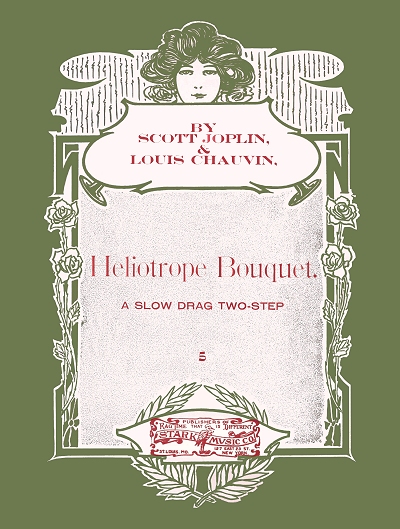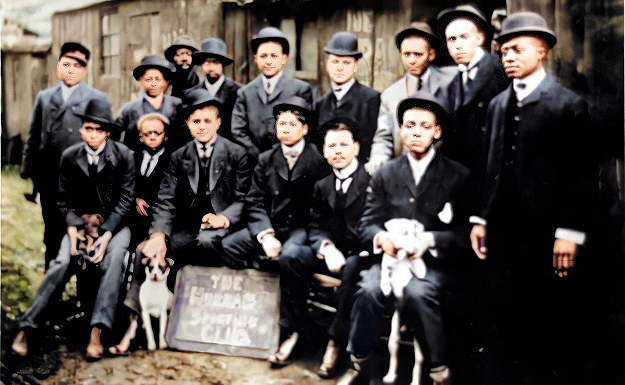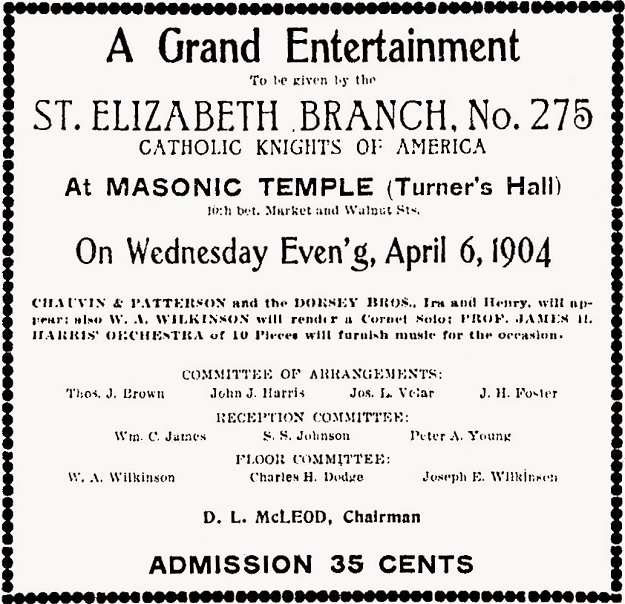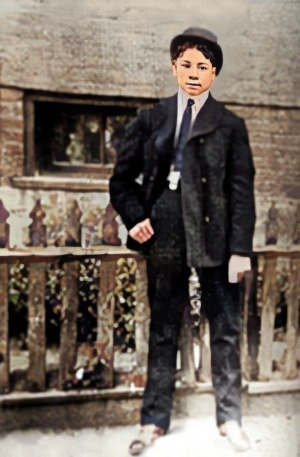|
Louis Ignatius Chauvin (February 24, 1884 to March 26, 1908) |
 Known Published Compositions Known Published Compositions |
|
The Moon is Shining in the Skies [w/Sam Patterson] (1903)
Dandy Coon: Musical [w/Sam Patterson] (1903) Babe, It's Too Long Off [w/Elmer Bowman] (1906) Heliotrope Bouquet [w/Scott Joplin] (1907) |
Louis Chauvin was well-known, well respected, well regarded, and reportedly the consummate ragtime musician and beyond. The tragedy is that he left virtually none of his life behind when he died so young. Chauvin was of mixed race. He was born in St. Louis, and until the 2019 it was thought to have been to a reportedly Mexican-Indian father and an African American mother, which was echoed on his death certificate. In the 1900 census Louis claimed that both of his parents were born in Missouri. In addition, his generally accepted birth month and year of March 1881 are further challenged by the census, in which Chauvin (spelled Shovan in the record) insisted it was February of 1882. There is now evidence to contradict even this notion, thanks to surviving members of the Chauvin family, particularly Robin Proudie, who very kindly has provided much of the information found in the following three paragraphs. Some of the family history is included here for further context about the environment in which Louis was raised.
Louis Ignatius Chauvin was the youngest child born to Charles Chauvin (c.4/1840) and Henrietta Mills (c.1844). His nine older siblings included Sylvester (11/1860-1), William Francis (1862), Abraham "Able" (1865), Peter (1870), Mary Elizabeth (1871), Julia (1873), Rosine (1874), Lincoln "Link" (1877), and Jerome Alexander [possibly Gerome] (1878). Charles had been enslaved to a Saint Louis woman named Amanda Curtis, and according to their June 28, 1860, marriage record, Henrietta was listed as a "slave of St. Louis University." They were wed at St. Francis Xavier College Church on the University campus, where Henrietta had been confirmed at age ten. Missouri had been admitted as a slave state in 1820 under legislation referred to as "The Missouri Compromise," which allowed Maine to join as a free state. However, the act was initially repealed in 1854 by the Kansas-Nebraska act, and was ruled as unconstitutional in 1857 owing to the result of the Dred Scott case in the United States Supreme Court. Yet it persisted, and Missouri became the twelfth state to secede from the Union in 1861, only to have it under Union control by mid-year, with only a shadow-Confederacy in the southeast part of the state trying to make a stand. Just prior to this, however, slavery still existed in Missouri in 1860, and both Charles and Henrietta were listed as enslaved at the time they were married.
However, the act was initially repealed in 1854 by the Kansas-Nebraska act, and was ruled as unconstitutional in 1857 owing to the result of the Dred Scott case in the United States Supreme Court. Yet it persisted, and Missouri became the twelfth state to secede from the Union in 1861, only to have it under Union control by mid-year, with only a shadow-Confederacy in the southeast part of the state trying to make a stand. Just prior to this, however, slavery still existed in Missouri in 1860, and both Charles and Henrietta were listed as enslaved at the time they were married.
 However, the act was initially repealed in 1854 by the Kansas-Nebraska act, and was ruled as unconstitutional in 1857 owing to the result of the Dred Scott case in the United States Supreme Court. Yet it persisted, and Missouri became the twelfth state to secede from the Union in 1861, only to have it under Union control by mid-year, with only a shadow-Confederacy in the southeast part of the state trying to make a stand. Just prior to this, however, slavery still existed in Missouri in 1860, and both Charles and Henrietta were listed as enslaved at the time they were married.
However, the act was initially repealed in 1854 by the Kansas-Nebraska act, and was ruled as unconstitutional in 1857 owing to the result of the Dred Scott case in the United States Supreme Court. Yet it persisted, and Missouri became the twelfth state to secede from the Union in 1861, only to have it under Union control by mid-year, with only a shadow-Confederacy in the southeast part of the state trying to make a stand. Just prior to this, however, slavery still existed in Missouri in 1860, and both Charles and Henrietta were listed as enslaved at the time they were married.It was either the enforcement of Union control of Missouri in mid-1861 or the Emancipation Proclamation that became law on January 1, 1864, that freed the Chauvins. Soon after, Charles was drafted into the U.S. Colored Infantry at some point in 1864, and then served from November 10, 1864, until September of 1865, having a discharge on November 11 of that year. Charles rose from a private in the 7th U.S. Colored Artillery to a sergeant of the 11th U.S. Colored Infantry once the prior unit had been superseded by the newer one. He returned to Saint Louis soon after the war ended, and eventually found work as a porter, while Henrietta took in wash, a common occupation at that time. While an 1870 listing for the family was evasive, the 1880 enumeration further reinforces their working status, also showing Abraham working as a barber at age 16. Sylvester had married his new wife Mary and had moved out, living nearby, and working as a musician. However, due to an error in the original count, that enumeration was taken again in November 1880, showing Charles as a laborer, and Sylvester and his wife having moved back in with his parents at 909 12th Street, now working as a hotel waiter. Mary Chauvin would die in April 1884, shortly after the birth of Louis, and while there is no clear evidence that Sylvester was actually his father, a slight chance may remain. For the purposes of this narrative, Charles Chauvin will still be considered Louis' birth father. Charles died in 1890 when Louis was only six years-old. Henrietta took him and his nearest siblings to live with her one or another of her older sons over the next fifteen years.
Sylvester played on the Saint Louis Black Stockings baseball team, one of the first black sports organizations of its kind, from around 1883 to 1886. He was third baseman and a left fielder, and at one point was elected the team captain. However, he had also long been interested in music, and was even found in some early listings claiming that occupation as early as 1883. By the time of the 1900 census, Both Sylvester and Abraham were shown to be musicians, and listings in subsequent city directories and official records into the early 1910s further reinforce this status.
The same was true for Peter and Link outside of the enumeration. Sylvester was largely a brass player, including cornets. Link played strings, usually guitar but possibly banjo. It is unclear what instruments Peter and Abraham chose. Link's wife gave birth to a younger Sylvester Chauvin on August 15, 1901, and he eventually ended up living with Peter and his wife Cora before 1910, possibly for family or health reasons, as Link died of tuberculosis soon after in the summer of 1913.
 |
It is clear that Louis was raised in Saint Louis, and probably spent a lot of time living with one or another older brother. As a boy he picked up piano largely on his own, showing both a passion and a talent for the instrument. He also displayed an inherent sense of harmonic flow and melodic improvisation. Having been both baptized (3/9/1884) and confirmed (5/17/1896) in the Catholic church, it can be assumed he got some of his early training there as well. Saint Elizabeth Parish was initially founded in 1873 and encouraged integration of the races to a point. It was later suppressed from outside prohibitions by Cardinal Joseph Ritter in the early 20th century to reinforce this practice, but the die had already been cast by the time Louis attended there. A natural musician, Louis was both very capable of playing as well as composing, even if he could not notate it. Much of his composition was extemporaneous and fleeting. Brilliant tunes would flow forth from his fingers, then disappear the next day only to be replaced by something else just as fantastic. When he was around 13 years old, Louis and his good friend Sam Patterson left school and home to join the famous Alabama Jubilee Singers, a touring ensemble based in Saint Louis. This may have been when he started inflating his age a bit, leading to the earlier birth year contention.
When he was around 13 years old, Louis and his good friend Sam Patterson left school and home to join the famous Alabama Jubilee Singers, a touring ensemble based in Saint Louis. This may have been when he started inflating his age a bit, leading to the earlier birth year contention.
 When he was around 13 years old, Louis and his good friend Sam Patterson left school and home to join the famous Alabama Jubilee Singers, a touring ensemble based in Saint Louis. This may have been when he started inflating his age a bit, leading to the earlier birth year contention.
When he was around 13 years old, Louis and his good friend Sam Patterson left school and home to join the famous Alabama Jubilee Singers, a touring ensemble based in Saint Louis. This may have been when he started inflating his age a bit, leading to the earlier birth year contention.Chauvin was one of the great draws at Tom Turpin's Rosebud Café, where he encountered other well-known ragtime players and composers, including Scott Joplin. They were also part of a private club annex around the corner which they dubbed The Hurrah Sporting Club. Louis was also a member of a unique ragtime piano quartet made up of himself, Patterson, Tom Turpin and Joe Jordan. They performed for a short time at social events in Saint Louis. But Chauvin also engaged freely in the more unsavory activities that Saint Louis had to offer, including brothels, bars and opium dens, something that may have contributed to the ultimate defeat of his great talent.
There have been some rumors from time to time about a particular song or piano piece that Chauvin had composed put to paper, most unsubstantiated, although drafts exist of three pieces that were possibly put down by Sam Patterson. They were from a vaudeville musical play that Patterson and Chauvin wrote and produced together titled Dandy Coon, with Jordan as their musical director. In it, Chauvin sang and played piano, and both he and Patterson danced the cakewalk, often in women's attire. However, their act folded after just a few performances on the road. As per a series of advertisements in the weekly Saint Louis Palladium in March and April 1904, just prior to the opening of the 1904 Lewis and Clark Exposition (World's Fair) in Saint Louis, the Saint Elizabeth Parish branch of the Catholic Knights of America sponsored Louis and Sam and others for an April 6 evening performance in Turner's Hall at the Masonic Temple. Chauvin then joined Patterson performing at the Old Saint Louis beer hall on the Pike just outside of the fairgrounds during at least some of the run of the event.
Louis was described by Sam Patterson in They All Played Ragtime, written by Rudi Blesh and Harriet Janis, as follows:
[Chauvin was] about five feet five and never over 145 pounds. He looked delicate with his fine features and his long, tapering fingers, but he was wild and strong. He never gambled, but he stayed up, drank, and made lots of love. He loved women, but he treated them like dirt. He always had two or three. He loved whisky [sic], too, but he only seemed to be living when he was at the piano. It's authentic, I guess, that he smoked opium at the last.
Around 1906, Chauvin moved to Chicago as many other players were doing at that time. By this time, it has been assumed that syphilis was starting to ravage his mind and potential complications from multiple sclerosis were affecting his body. Recently a different theory has evolved, as will be explained. Somehow, he managed a brief stint at Pony Moore's club at 22nd and Dearborn. Scott Joplin visited Arthur Marshall in Chicago (some sources say Sedalia) in 1906 where he found the ailing Chauvin playing some beautiful syncopated themes. Two of these strains in particular were found to be particularly haunting to both, and Joplin wrote them down for later completion. Once the strains were harmonized by Joplin, and two more were composed with thematic tie-ins, he released it in 1907 as Heliotrope Bouquet, giving Chauvin the primary composer credit, and therefore some of the income derived from the work. This and two other minor songs were all that would be published
Recently a different theory has evolved, as will be explained. Somehow, he managed a brief stint at Pony Moore's club at 22nd and Dearborn. Scott Joplin visited Arthur Marshall in Chicago (some sources say Sedalia) in 1906 where he found the ailing Chauvin playing some beautiful syncopated themes. Two of these strains in particular were found to be particularly haunting to both, and Joplin wrote them down for later completion. Once the strains were harmonized by Joplin, and two more were composed with thematic tie-ins, he released it in 1907 as Heliotrope Bouquet, giving Chauvin the primary composer credit, and therefore some of the income derived from the work. This and two other minor songs were all that would be published
 Recently a different theory has evolved, as will be explained. Somehow, he managed a brief stint at Pony Moore's club at 22nd and Dearborn. Scott Joplin visited Arthur Marshall in Chicago (some sources say Sedalia) in 1906 where he found the ailing Chauvin playing some beautiful syncopated themes. Two of these strains in particular were found to be particularly haunting to both, and Joplin wrote them down for later completion. Once the strains were harmonized by Joplin, and two more were composed with thematic tie-ins, he released it in 1907 as Heliotrope Bouquet, giving Chauvin the primary composer credit, and therefore some of the income derived from the work. This and two other minor songs were all that would be published
Recently a different theory has evolved, as will be explained. Somehow, he managed a brief stint at Pony Moore's club at 22nd and Dearborn. Scott Joplin visited Arthur Marshall in Chicago (some sources say Sedalia) in 1906 where he found the ailing Chauvin playing some beautiful syncopated themes. Two of these strains in particular were found to be particularly haunting to both, and Joplin wrote them down for later completion. Once the strains were harmonized by Joplin, and two more were composed with thematic tie-ins, he released it in 1907 as Heliotrope Bouquet, giving Chauvin the primary composer credit, and therefore some of the income derived from the work. This and two other minor songs were all that would be publishedLouis Chauvin died early in 1908 after 23 days in an Illinois hospital, having just turned twenty-four. Two potential causes of death were cited, including multiple sclerosis and starvation from a coma. Syphilis has also been unofficially cited, but while present may have only been a contributing factor or a conjecture. Former Scott Joplin house manager Cookie Jordan had suggested another possibility; that of sickle cell anemia, more common in black people at that time than MS. Among the symptoms for those with a genetic inheritance of the sickness, stunted or slowed growth is normal, it can shut down certain organs creating a yellowing of the skin, and it was quite painful (as per information from the Mayo clinic). MS would have more than likely adversely affected his performance skills and ended his career more than a year before his death because of major muscle control issues, and this was evidently not the case. Given the extreme pain from SCA, a controlled substance like opium would have commonly been used to help negate that pain, accounting for his addiction. This would mean that despite his hard sporting lifestyle (which again is a factor that has been relayed by historical word of mouth), genetics may have been much more responsible for Louis' death at age twenty-four.
The composer was sent back to his hometown and buried in Calvary cemetery in Saint Louis on March 30. The whereabouts of his grave were not known until mid-2007 (see below), and the plot has since been marked with a proper headstone. There were also efforts being made to better define his lineage and any historical links to either MS or SCA. Despite the enhanced information on his family, nothing definitive has been discerned on those diseases as of 2025.
Thanks go to former Scott Joplin House staffer Almetta "Cookie" Jordan and Friends of Scott Joplin volunteer Steve Hinson who discovered the existence and whereabouts of Chauvin's plot in August 2007. For contact information or to donate to the headstone, visit the Scott Joplin House page. Additional huge thanks to Robin Proudie, a descendant of Louis, and the Society of Jesuits who did some extraordinary digging on the Chauvin family of the late 19th century. Robin shared much of this information with us and follow-up was then done to add context and a few points. A lot of mysteries were resolved by their collective work.